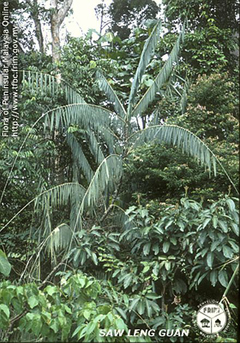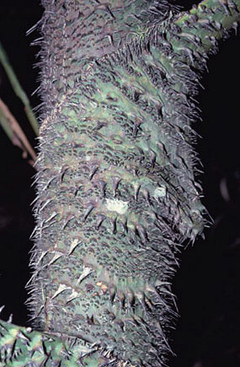 |
|
Malaysian Biological Diversity. |
 |
| Dr. John Dransfield, Royal Botanic Gardens, Kew/Palmweb. |
Translate this page:
Summary
Rotan Manau or Calamus manan is a vigorous, high climbing, single stem, dioecious plant with a strong cane up to 8cm in diameter. This species in particular has the best quality cane. Stems of rotan manau are used in making furniture. Found In: Perak, Selangor, Kelantan, Pahang, Trengganu, Negri Sembilan, Johore. Sumatra, Borneo, and S. Thailand. Common names: Rotan Manau
Physical Characteristics

 Calamus manan is an evergreen Climber growing to 100 m (328ft) by 7 m (23ft) at a fast rate.
Calamus manan is an evergreen Climber growing to 100 m (328ft) by 7 m (23ft) at a fast rate.
See above for USDA hardiness. It is hardy to UK zone 10 and is frost tender.
Suitable for: light (sandy), medium (loamy) and heavy (clay) soils and prefers well-drained soil. Suitable pH: mildly acid, neutral and basic (mildly alkaline) soils. It can grow in semi-shade (light woodland) or no shade. It prefers moist soil.
UK Hardiness Map
US Hardiness Map
Synonyms
Calamus giganteus Becc.
Plant Habitats
Edible Uses
References More on Edible Uses
Medicinal Uses
Plants For A Future can not take any responsibility for any adverse effects from the use of plants. Always seek advice from a professional before using a plant medicinally.
None known
References More on Medicinal Uses
The Bookshop: Edible Plant Books
Our Latest books on Perennial Plants For Food Forests and Permaculture Gardens in paperback or digital formats.

Edible Tropical Plants
Food Forest Plants for Hotter Conditions: 250+ Plants For Tropical Food Forests & Permaculture Gardens.
More

Edible Temperate Plants
Plants for Your Food Forest: 500 Plants for Temperate Food Forests & Permaculture Gardens.
More

More Books
PFAF have eight books available in paperback and digital formats. Browse the shop for more information.
Shop Now
Other Uses
Furniture Wood
Other uses rating: High (4/5). Other Uses: The stems are used for making furniture[ 310 ]. This species is said to produce the best quality large-diameter cane in the genus, and it is much sought after for making furniture[ 310 ]. The cane is variable in size and colouration. It is durable, has great strength and flexibility and is used mainly as the framework of furniture[ 310 ]. Growth rates of over 7 m a year.
Special Uses
References More on Other Uses
Cultivation details
Most species in this genus are more or less vigorous climbing plants in rainforests. In general, they are likely to grow best with their roots in the shade but with their stems able to grow up to the light. They are also likely to grow best in a humus-rich soil[ K ]. About 24 months after field planting, the cirri develop, after which the aerial stems may grow at rates between 1 - 3 metres or more per year[ 310 ]. Flowering may begin in the fifth year after planting and is annual thereafter[ 310 ] Seedlings are produced abundantly in hill forests[ 310 ]. A period of 15 years is estimated for plantation-grown plants to reach harvestable state[ 310 ] Harvesting of the stems involves dragging the rattan from the canopy, removing dead leaf-sheaths and debris and discarding the uppermost 2 - 3 metres, which are immature and too soft for use. The leaf-sheaths and debris are usually removed by coiling and pulling the rattan stem around a conveniently placed small tree trunk, resulting in a clean stem. The cane is then cut into 3 metre lengths suitable for bundling and transport out of the forest to the processor. A dioecious species, both male and female forms need to be grown if fruit and seed are required.
References Carbon Farming Information and Carbon Sequestration Information
Temperature Converter
Type a value in the Celsius field to convert the value to Fahrenheit:
Fahrenheit:
The PFAF Bookshop
Plants For A Future have a number of books available in paperback and digital form. Book titles include Edible Plants, Edible Perennials, Edible Trees,Edible Shrubs, Woodland Gardening, and Temperate Food Forest Plants. Our new book is Food Forest Plants For Hotter Conditions (Tropical and Sub-Tropical).
Shop Now
Plant Propagation
Seed - needs to be sown as soon as possible since it has a very short viability. The fruit wall and the fleshy seed-coat must be removed before sowing and the clean seeds kept moist, as any drying out will cause the embryo to die. Seeds are usually sown in seed-beds in the shade. They germinate in 3 - 15 weeks[ 310 ]. They are potted in polybags when the first leaf has emerged. Once potted, seedlings should be kept in the shade and provided with plenty of moisture without waterlogging. Seedlings are usually ready for planting 9 - 12 months after transplanting into bags and require tree support[ 310 ]. Seedlings require about 50% relative light intensity for establishment and growth[ 310 ]. Seed stored will not tolerate temperatures below 10C for periods exceeding 2 months and seed moisture content needs to be about 50%; whole fresh fruits can be stored up to 2 weeks in well ventilated conditions at 22-28C without appreciable loss of viability[ 310 ].
Other Names
If available other names are mentioned here
Rotan Manau or Calamus manan.
Native Range
TROPICAL ASIA: Indonesia (Kalimantan, Sumatera), Malaysia (Malaya)
Weed Potential
Right plant wrong place. We are currently updating this section.
Please note that a plant may be invasive in one area but may not in your area so it's worth checking.
None Known
Conservation Status
IUCN Red List of Threatened Plants Status : This taxon has not yet been assessed.

| Related Plants
|
| Latin Name | Common Name | Habit | Height | Hardiness | Growth | Soil | Shade | Moisture | Edible | Medicinal | Other |
| Acorus calamus | Sweet Flag - Calamus | Perennial | 1.0 |
4-11
| M | LMH | N | WeWa | 3 | 4 | 4 |
| Calamus caesius | Rotan Sega | Climber | 100.0 |
10-12
| F | LMH | SN | M | 2 | 0 | 4 |
| Calamus ovoideus | Egg-shaped Rattan. Rotan Ovoid | Climber | 70.0 |
10-12
| F | LMH | SN | M | 2 | 0 | 4 |
| Calamus radiatus | Rotan Rays. Radial Leaf Rotan | Climber | 50.0 |
11-12
| F | LMH | SN | M | 0 | 0 | 4 |
| Calamus rotang | Rattan, Rotang, Rattan Cane | Climber | 25.0 |
11-12
| F | LMH | SN | M | 2 | 2 | 4 |
| Calamus spp. | Rattan Palm | Perennial | 50.0 |
10-12
| M | LMH | SN | M | 2 | 2 | 5 |
| Dendrocalamus asper | Giant Bamboo, Dragon bamboo, Sweet bamboo | Bamboo | 15.0 |
10-12
| F | LMH | N | M | 4 | 0 | 3 |
| Dendrocalamus brandesii | Velvet Leaf Bamboo, Clumping Bamboo | Bamboo | 25.0 |
9-10
| F | LMH | N | M | 3 | 0 | 4 |
| Dendrocalamus giganteus | Giant Bamboo, Bhalu bans, Dhungre bans | Bamboo | 30.0 |
9-12
| F | LMH | SN | M | 2 | 1 | 4 |
| Dendrocalamus hamiltonii | Tama Bamboo. Tufted bamboo | Bamboo | 15.0 |
10-12
| F | LMH | SN | M | 3 | 0 | 3 |
| Dendrocalamus hookeri | Bhalu bans, Bhutan Green Bamboo | Bamboo | 20.0 |
10-12
| F | LMH | SN | M | 2 | 0 | 3 |
| Dendrocalamus latiflorus | Sweet Bamboo, Sweet bamboo shoot, Taiwan giant bamboo | Bamboo | 20.0 |
10-12
| F | LMH | N | M | 4 | 0 | 2 |
| Dendrocalamus membranaceus | White bamboo | Bamboo | 15.0 |
10-12
| F | LMH | SN | DM | 3 | 0 | 4 |
| Dendrocalamus strictus | Male Bamboo. Calcutta Stricta or Bamboo | Bamboo | 15.0 |
9-12
| F | LMH | SN | DM | 3 | 1 | 3 |
| Himalayacalamus asper | | Bamboo | 6.0 |
-
| F | LMH | SN | M | 0 | 0 | 2 |
| Himalayacalamus brevinodus | | Bamboo | 9.0 |
-
| F | LMH | SN | M | 2 | 0 | 2 |
| Himalayacalamus cupreus | | Bamboo | 6.0 |
-
| F | LMH | SN | M | 3 | 0 | 2 |
| Himalayacalamus falconeri | | Bamboo | 6.0 |
7-10
| S | LMH | SN | M | 3 | 0 | 2 |
| Himalayacalamus fimbriatus | | Bamboo | 6.0 |
-
| F | LMH | SN | M | 1 | 0 | 2 |
| Himalayacalamus hookerianus | Padang | Bamboo | 9.0 |
7-10
| F | LMH | SN | M | 2 | 0 | 3 |
| Indocalamus latifolius | | Bamboo | 1.0 |
7-10
| | LMH | S | M | 0 | 0 | 1 |
| Thamnocalamus aristatus | | Bamboo | 6.0 |
5-9
| | LMH | SN | M | 2 | 0 | 3 |
| Thamnocalamus spathaceus | Umbrella Bamboo | Bamboo | 4.0 |
5-9
| | LMH | FSN | M | 0 | 0 | 2 |
| Thamnocalamus spathiflorus | | Bamboo | 6.0 |
5-9
| | LMH | SN | M | 2 | 0 | 3 |
| Thamnocalamus tessellatus | Bergbamboes | Bamboo | 3.5 |
-
| | LMH | SN | DM | 0 | 0 | 2 |
|
Growth: S = slow M = medium F = fast. Soil: L = light (sandy) M = medium H = heavy (clay). pH: A = acid N = neutral B = basic (alkaline). Shade: F = full shade S = semi-shade N = no shade. Moisture: D = dry M = Moist We = wet Wa = water.
Now available:
Food Forest Plants for Mediterranean Conditions
350+ Perennial Plants For Mediterranean and Drier Food Forests and Permaculture Gardens.
[Paperback and eBook]
This is the third in Plants For A Future's series of plant guides for food forests tailored to
specific climate zones. Following volumes on temperate and tropical ecosystems, this book focuses
on species suited to Mediterranean conditions—regions with hot, dry summers and cool, wet winters,
often facing the added challenge of climate change.
Read More
Expert comment
Author
Miq.
Botanical References
Links / References
For a list of references used on this page please go here
A special thanks to Ken Fern for some of the information used on this page.
Readers comment
| Add a comment |
|
If you have important information about this plant that may help other users please add a comment or link below. Only comments or links that are felt to be directly relevant to a plant will be included. If you think a comment/link or information contained on this page is inaccurate or misleading we would welcome your feedback at [email protected]. If you have questions about a plant please use the Forum on this website as we do not have the resources to answer questions ourselves.
* Please note: the comments by website users are not necessarily those held by PFAF and may give misleading or inaccurate information.
To leave a comment please Register or login here All comments need to be approved so will not appear immediately.
|
|